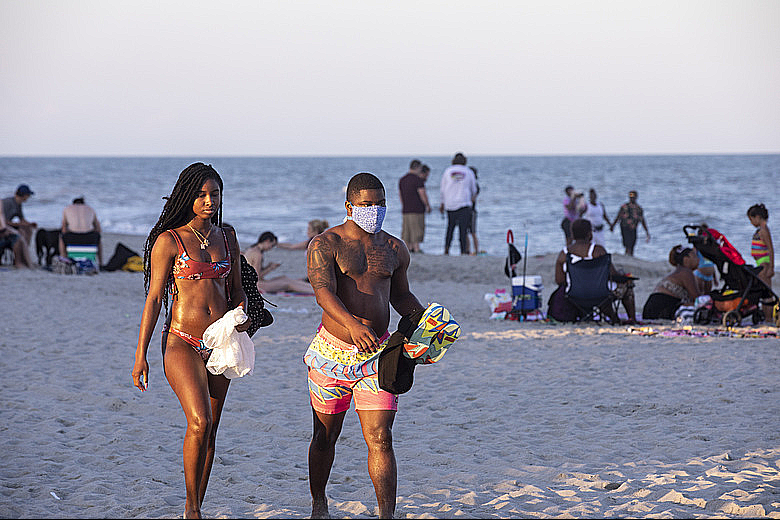Even if we escaped getting sick from the coronavirus, we are all sick of staying at home, practicing social distancing and wearing masks. While case numbers and deaths from COVID-19 are trending downward, this is not the time to let down your guard. These are not ordinary days. These novel days call on us to make decisions with limited and evolving information. The coronavirus is still circulating.
As a physician who has practiced for over 30 years, I find myself facing the decisions about safe outdoor recreation with some trepidation. The decision about whether to go to a beach, a pool or a park was previously pretty simple – now, not so much.
On one hand, there is too much information, some of it conflicting and much of it infused with political ideology. On the other, there is a lack of information – the “novel” in novel coronavirus means it’s new and there is much we don’t know. While it remains as true as ever that there are tremendous benefits to going outside these days, it’s also true there are risks to yourself and to others in doing so.
How to decide whether you and your loved ones can go hiking, beaching or swimming? Let’s begin with some facts that we actually do know. We know that the virus can be carried asymptomatically, and we know that there are people at disproportionately high risk of serious complications.
We scientists and doctors don’t know yet if having antibodies is indicative of immunity, so a positive antibody test doesn’t mean you’re good to go without risk. We know that the number of virus particles you are exposed to and the duration of exposure are vital factors determining risk of transmission.
Also, at least one preprint study, which has not been peer-reviewed, found that the risk of outdoor exposure is much less than that indoors.
But I want to be outside
Now that almost all states have opened back up, in varying degrees, it is important to remember that the virus is still out there. The risks of getting infected when passing by a runner or cyclist fairly quickly are not terribly high, at least in the absence of a sneeze or cough, and are even lower at a distance. Solitary activities transmit fewer particles than team sports or horseplay in the pool.
Going alone or only with the people in your quarantine bubble will minimize your risk. Proximity to people outside your bubble means you should wear a mask properly to protect others. The quarantine bubble is shorthand for a small group of friends you may choose to get together with who have followed social distancing guidelines and whom you know to be healthy. The safety of your bubble, however, is only as good as the agreement between members to follow safety precautions outside the bubble.
Look at the logistics of your plan. It’s worth breaking your intended activity down to basic steps.
- How will you get there? Remember, public transportation and air travel are still high-risk. And, if you are driving on the highway or interstate, remember that you might need to stop for bathroom breaks. In the spirit of “better safe than sorry,” if you do travel long distances by car, bring your own food and water as well as a hygiene kit containing wipes, paper towels, travel soap and sanitizer.
- What will I need while there? Consider the need for bathroom breaks, food and water, your ability to wash hands and maintain distance. Bathrooms and changing rooms are full of “high touch” surfaces, and while definitive information is lacking, early evidence demonstrates virus persistence on surfaces. You should treat public bathrooms as high-risk areas and keep in mind that many may not even be open.
Once at your destination, remember the coronavirus basics:
- Keep a distance of at least six feet.
- Wash and disinfect your hands often – and definitely after touching any shared surface.
- Keep your hands away from your face.
- Wear a mask.
- If at a park, walk or hike single file and leave room for others to pass at a safe distance. Consider going at off-peak hours and to less popular locations.
- If going to the beach, you still need to wear a mask. And keep your distance.
- If going to the pool, remember that although there is no evidence of spread through water that has been treated per recommendations, common areas require distancing, masks and the other usual precautions.
Remember the real estate adage “location, location, location.” The virus prevalence and the slope – whether cases are rising or falling – in your area matter. Also, the availability of testing and of hospital beds in your area are things to consider.
You should take into account the regulations and laws in your area, understanding that they may not reflect public health guidelines. If in doubt, err on the side of protection.
Factors out of your control
Finally, there is the wild card of figuring out what the people around you will be doing to protect you as you are deciding how you will protect yourself, your loved ones and them. Will they respect your space and wear masks? The final word on outdoor recreation? Of course, go out and be active. It’s important for your mental and physical health. But, choose wisely, be prepared and stay safe.
Dr. Claudia Finkelstein writes for The Conversation and is the director of wellness, resiliency and support at Michigan State University. Her current main area of interest is that of physician health, believing that well-adjusted, resilient, thriving physicians will provide excellent care to their patients, teaching to their trainees, and be a positive presence to their loved ones.
